Welcome to the world of fishing, where catching fish meets the calm of nature. Starting out, it can feel overwhelming with all the fishing equipment out there. But don’t worry, this guide will help you find the key angling essentials for a great start. You’ll learn how to pick the perfect starter fishing kit and understand your local fishing spots.
Every beginner can start fishing with confidence. This guide covers the basics, like choosing the right rod and reel for fish like trout, walleye, and bass. You’ll also learn about fishing lines and lures for your tackle box.
Fishing is not just about catching fish. It’s about patience, skill, and caring for our planet. As you get your gear ready, remember that fishing is a hobby that supports conservation and wildlife respect. With this guide, you’re not just fishing—you’re starting a lifelong passion.
Contents
Key Takeaways
- Assemble your core fishing arsenal with a suitable rod and reel combo.
- Understand the importance of matching the right fishing line with your equipment.
- Master the use of various lures and baits to attract your desired catch.
- Equip yourself with a functional tackle box filled with practical tools and accessories.
- Dress appropriately for the elements, with protective clothing and sun-resistant gear.
- Stay informed on fishing licenses and regulations to ensure a lawful angling experience.
- Learn how to care for and store your fishing gear to maintain its longevity.
Introduction to Fishing Basics for New Anglers
Starting your fishing journey can be very rewarding. Knowing the basics of beginner’s fishing techniques and fishing location selection helps a lot. Learning the key angling principles can improve your chances of catching fish. Also, picking the right spot can make your fishing trip more fun.
Understanding Basic Fishing Techniques
For beginners, learning a few basic techniques is key. Spinning rods and reels are great for newbies because they’re easy to use and catch many freshwater fish. Starting with these techniques helps build a strong base and boosts your confidence as you catch your first fish.
It’s best to start with smaller fish and use ultralight models to get better at your technique.
Choosing Your First Fishing Location
Choosing the right fishing spot is crucial. Look for places that are good for beginners and have lots of fish. Make sure the spot is easy to get to and safe.
Always check local rules to make sure your fishing methods and bait are allowed. This helps protect local wildlife and makes your fishing trip better by avoiding problems.
Essential Fishing Gear for Beginners
Starting your fishing journey means getting the right fishing gear essentials. For beginners, picking the right beginner fishing equipment is key for a good time and success. This guide will show you the angling gear for starters you can’t miss.
For new anglers, a good rod and reel combo is a must. It should work well in different places and for various fish, making it easy to use. Here’s a table with gear suggestions for different fishing situations.
| Gear Type | Description | Best Used For |
|---|---|---|
| Spinning Rod and Reel | Light to medium power, easy handling | Beginners, small to medium freshwater fish |
| Baitcaster Combo | Higher precision and control, requires practice | Experienced anglers, larger freshwater species |
| Fly Fishing Rod | Specialized for casting lightweight lures | Trout and salmon in streams |
Choosing the right lures is also important. Different fish and places need different lures to catch them. You’ll find jigs, spinners, plugs, and soft plastics, each appealing to different fish.
Don’t forget about practical tools like a good fishing knife and strong pliers. They help set up and adjust your gear and are crucial when catching fish, like cutting lines or removing hooks.
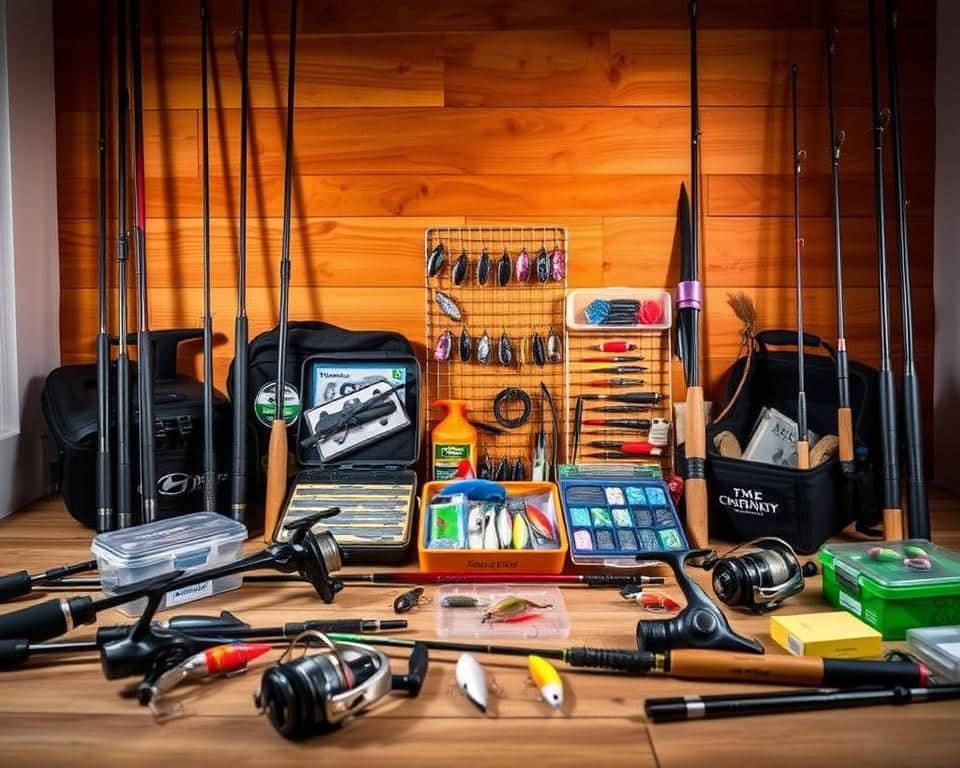
When you get your angling gear for starters, remember each piece is important for success and fun. Quality fishing gear essentials prepare you for many fishing situations. They also last long and perform well, leading to many great fishing experiences.
The Rod and Reel Combo: Starting Off Right
Starting your fishing journey needs the right gear. Choosing the right rod and reel combos is key for beginners. It affects how well and how much you enjoy fishing. We’ll help you pick the best spinning rods and reels for a great start.
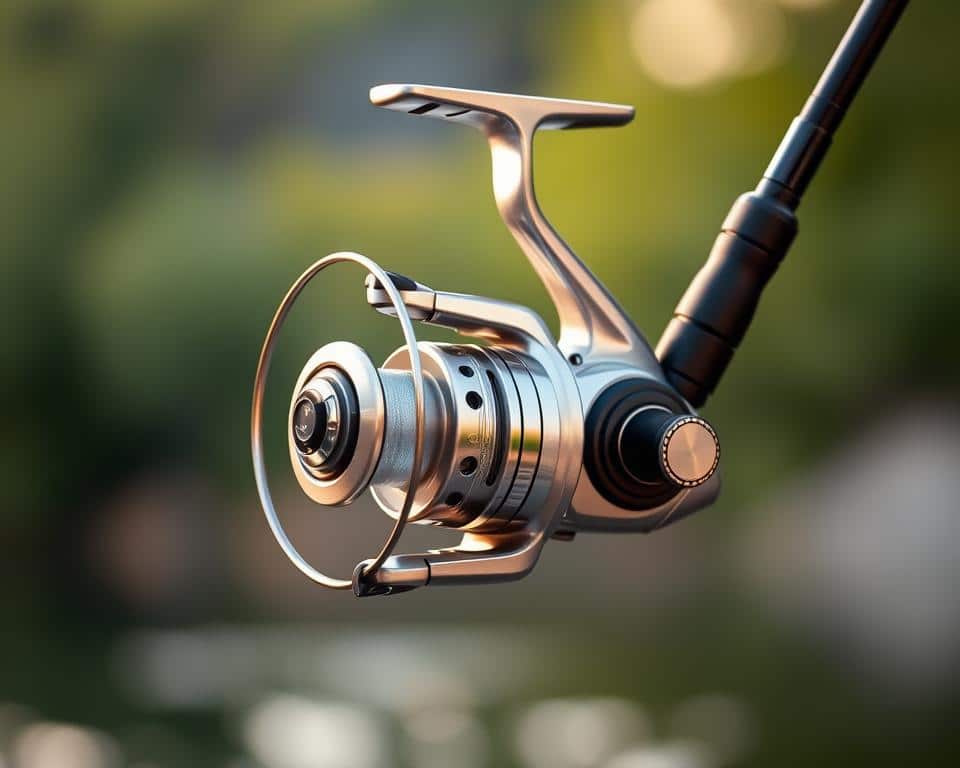
Selecting the Perfect Fishing Rod
Choosing a spinning rod can seem hard for beginners. But, light to medium power rods are a good start. They work well for many fish, like trout and bass. They’re great for beginners because they’re versatile.
For catching smaller fish, like trout, an ultralight rod is perfect. It’s a fun way to learn and improve your skills.
Choosing an Appropriate Reel
Choosing a reel to go with your rod is important. A spinning reel in the 2000 to 3000 size range is best for light to medium rods. These reels are easy to use and smooth, which is great for beginners. They can handle many fish species.
| Fish Type | Recommended Rod Power | Reel Size |
|---|---|---|
| Trout, Panfish | Ultralight to Light | 2000 |
| Walleye, Bass | Medium | 2500-3000 |
| Northern Pike | Medium to Heavy | 3000 |
Using this guide to pick your first rod and reel combo will help you succeed in fishing. The right gear makes fishing easier and more fun. It can start a lifelong love for fishing.
Understanding Fishing Lines and Their Importance
Fishing lines might not always catch the eye like flashy lures or sophisticated reels. But, they play a crucial role in angling success. The right fishing line can greatly affect your fishing experience and success rates, whether in freshwater or saltwater.
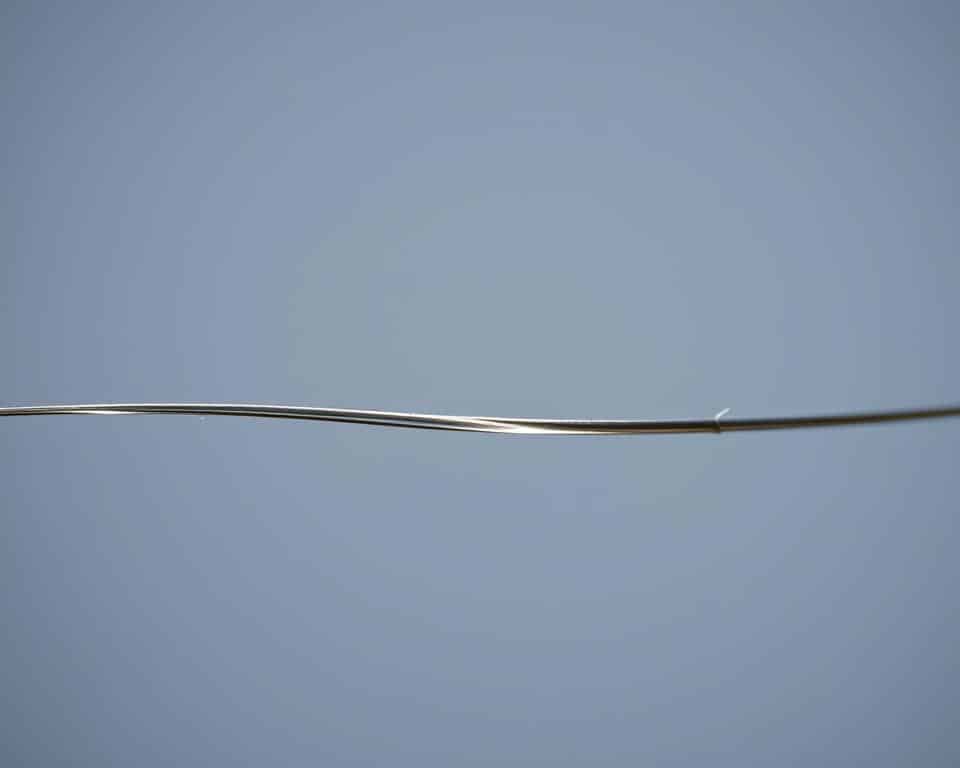
Different Types of Fishing Lines
There are several key types of fishing lines, each with unique properties. The monofilament line is versatile and popular among beginners. It offers a good balance of strength, flexibility, and cost.
The fluorocarbon line is nearly invisible underwater. This makes it perfect for clear waters where fish are easily spooked.
How to Select the Right Fishing Line
Choosing the right fishing line involves considering several factors. These include water conditions, the fish species, and the lure or bait used. Beginners should start with a line that has a test strength between 6 and 12 pounds. This ensures durability and usability.
| Fishing Line Type | Key Properties | Best Use Cases |
|---|---|---|
| Monofilament | Flexible, stretchable, cost-effective | General freshwater fishing, topwater lures |
| Fluorocarbon | Near invisible, higher density, slight stretch | Clear water fishing, leader material |
| Braided Line | Very strong, no stretch, durable | Heavy cover fishing, deep sea fishing |
Understanding the characteristics of monofilament and fluorocarbon lines helps amateur anglers. It allows them to make informed decisions. This can enhance their fishing effectiveness and enjoyment of this rewarding outdoor activity.
Types of Lures and Baits for Beginner Anglers
As a beginner angler, knowing the many fishing lures and baits can make fishing better. The right choice can help you catch more fish and improve your skills. We look at live and artificial baits, each good for different fishing situations and targeting fish species.
Live Baits vs Artificial Lures
Live baits like worms and minnows are popular for attracting many fish. They move naturally and smell good to predators. But, artificial baits have gotten better, looking and acting like live bait. This lets you catch more fish in different waters.
Lure Selection Based on Target Fish Species
Choosing the right fishing lures means picking ones that look like the fish’s usual food. For bass, try crankbaits or spinnerbaits. Here’s a simple guide to pick the best lures for different fish.
| Fish Species | Recommended Lures | Conditions |
|---|---|---|
| Bass | Spinnerbaits, Crankbaits | Calm, murky water |
| Trout | Spoons, Soft Plastics | Clear, fast-moving water |
| Pike | Jerkbaits, Large Spinners | Weedy, deep areas |
| Walleye | Jigs, Minnow Baits | Sandy bottoms |
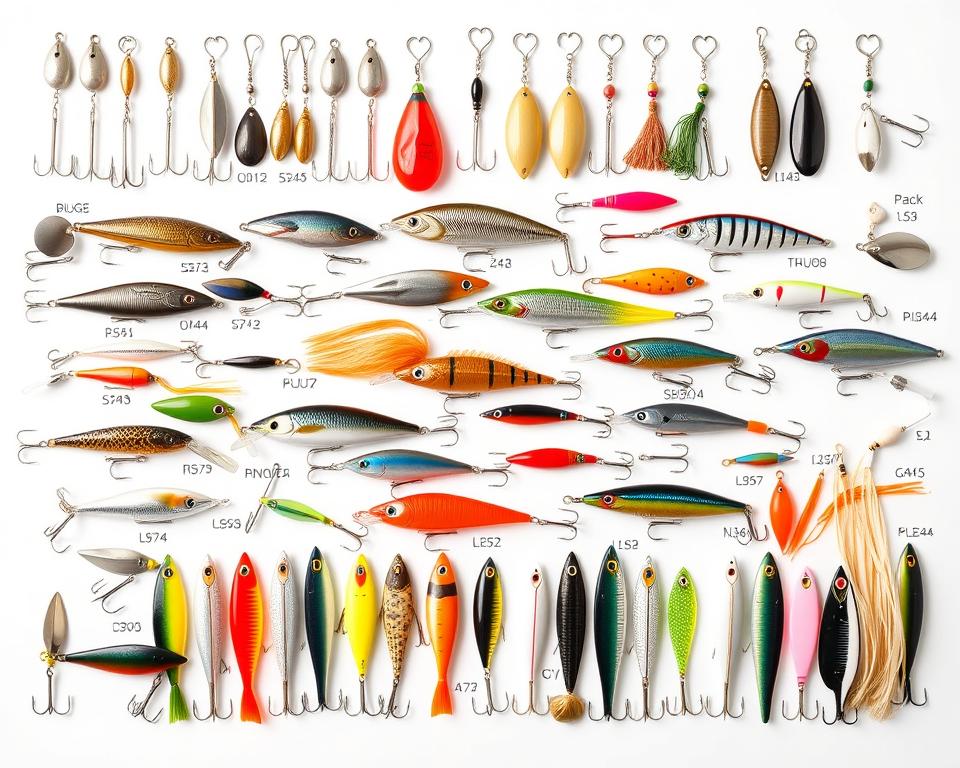
This table is a good start for beginners picking fishing lures. Always think about the fish’s environment and behavior when choosing a lure. This will help you catch more fish.
Knowing the rules for fishing is key for anyone wanting to fish legally and responsibly. Places like Quebec or Ontario have their own rules. It’s important to know these rules, whether you’re a first-time fisher or a pro, to have a good time.
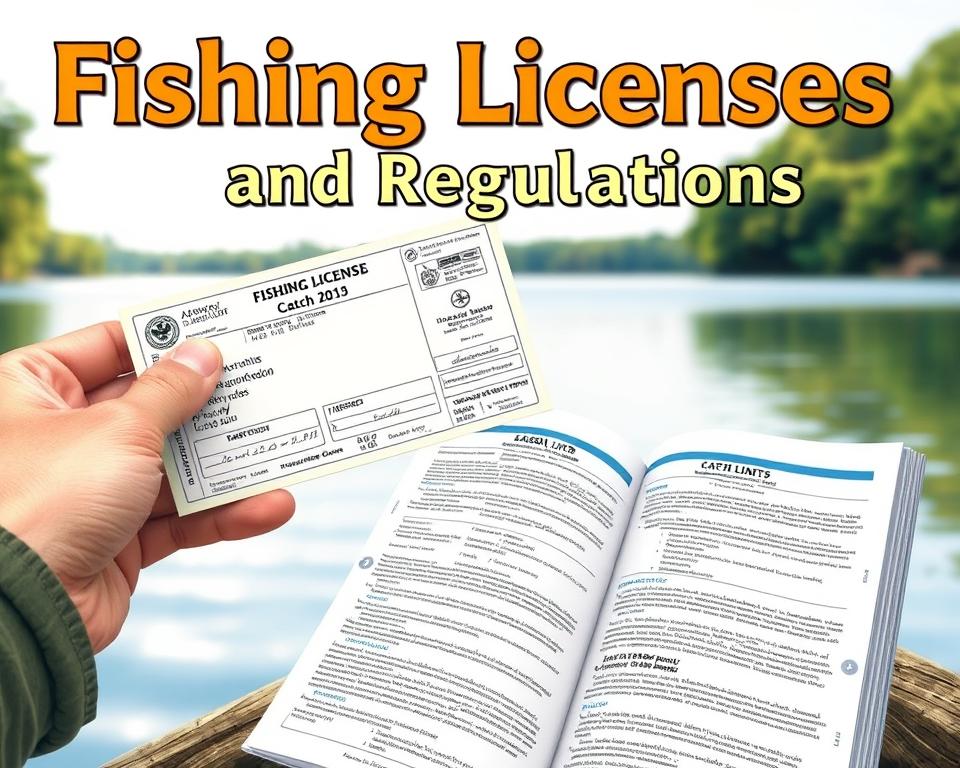
Getting the right fishing licenses is your first step. You can choose from short-term passes for visitors or annual permits for locals. There are also special licenses for catching certain fish, like Atlantic salmon. This shows why it’s important to know the angling regulations for the fish you want to catch.
Following local fishing regulations is more than just fishing legally. It’s also about helping fish populations stay healthy. These rules include limits on how many fish you can catch and how big they can be. Breaking these rules can lead to fines and harm the environment.
Knowing and following these rules makes fishing fun and responsible. It helps keep the sport alive for others in the future. Always check for the latest rules before you go, as they can change based on new research and environmental studies.
Practical Tools and Accessories Every Angler Needs
For a better fishing experience, you need the right fishing tools and angling accessories. These include items that help you catch fish and ensure your safety and comfort. Knowing what to carry can greatly improve your fishing trips.
Fishing Pliers, Knives, and Other Must-Haves
Fishing pliers and a sharp knife are key fishing tools every angler needs. Pliers help remove hooks and cut lines. A good knife is for cleaning fish and cutting bait. Don’t forget landing nets, scales, and scissors for your basic setup.
The Importance of a Reliable Tackle Box
Keeping your tackle box essentials organized is crucial. A good tackle box has hooks, sinkers, floats, swivels, and lures for any fishing situation. Modern tackle boxes have compartments to keep everything neat and easy to find.
- Fishing Line
- Various hooks
- Lures
- Bobbers
- Sinkers
Choosing the right tackle box is as important as the gear it holds. It should be organized and easy to access.
| Accessory | Use | Benefit |
|---|---|---|
| Fishing Pliers | Removing hooks, cutting lines | Multi-functional tool, essential for effective hook management |
| Reliable Knife | Cutting bait, cleaning fish | Indispensable for preparation tasks |
| Landing Nets | Securing fish | Provides a safe way to handle and land caught fish |
| Tackle Box | Storing fishing gear | Helps organize and provide easy access to your fishing tools |
Using these essential tools and keeping your tackle box organized can greatly improve your fishing. It makes every trip more productive and fun.
Maintaining and Storing Your Fishing Gear
Proper fishing gear maintenance is key to keeping your equipment in top shape. This includes rods, reels, lures, and baits. Taking good care and using the right storage solutions can greatly improve gear longevity.
Cleaning your rod and reel regularly is important. It prevents salt, dirt, and grime from building up. This ensures they work well on your next fishing trip. Always check your line for wear or fraying to avoid failures during important catches.
Choosing the right way to store your gear is also crucial. The right techniques and solutions can make a big difference.
| Gear Component | Care Tips | Storage Solutions |
|---|---|---|
| Rods | Clean with fresh water and mild soap. Check regularly for any damage or signs of wear. | Store vertically in a rod rack or horizontally in a padded rod case. |
| Reels | Lubricate bearings and moving parts periodically. Tighten any loose screws and check for corrosion. | Keep in a cool, dry place, ideally in a reel bag or cabinet that protects from dust. |
| Lines | Rinse lines in freshwater after each use, particularly when fishing in saltwater environments. Check for tangles or knots. | Loosely coil to avoid kinks and store away from direct sunlight. |
| Lures and Baits | Wash with fresh water and dry completely to prevent rust on hooks. | Organize in a tackle box with dividers to prevent tangling and easier accessibility. |
To keep your fishing gear in top condition, follow these best practices. Regular checks and proper storage help maintain functionality. This ensures you’re ready for your next fishing adventure.
Dressing for Success: Essential Fishing Apparel
Choosing the right fishing apparel is key for comfort and safety. Advanced fabrics protect you from the sun’s harmful rays. They also keep bugs away, so you can enjoy your fishing trip more.
Whether you’re fishing at a calm lake or a fast stream, the right clothes make a big difference. Brands like Columbia make special fishing clothes. They keep you cool and block the sun’s rays.
- Protective Clothing and Footwear for Fishing: Wear lightweight, breathable clothes that dry fast. Good waterproof shoes are a must, especially when wading.
- Choosing Sun Protection and Bug-Resistant Gear: Long-sleeved shirts and pants with UV protection are smart choices. Hats and mosquito nets offer extra protection from the sun and bugs.
Knowing what fishing apparel to choose can make your fishing trips better. The right clothes keep you comfortable and safe from the elements. This helps you fish better and enjoy your time more.
Conclusion
Starting to fish can be very exciting. For beginners, there’s a lot to learn. This guide has covered the basics, from choosing the right gear to understanding lures.
Now, you know how to pick the right line and take care of your equipment. You also know how to dress for fishing. Each step you take is filled with confidence.
Remember, fishing is more than just gear. It’s about following the rules and caring for nature. These tips help you start fishing the right way and keep it up.
Fishing is a rewarding journey. This guide has prepared you for it. Catching your first fish is a great feeling.
So, get ready for many good fishing trips. With your gear and knowledge, your fishing adventures will be memorable. May they lead to a lifetime of great memories.
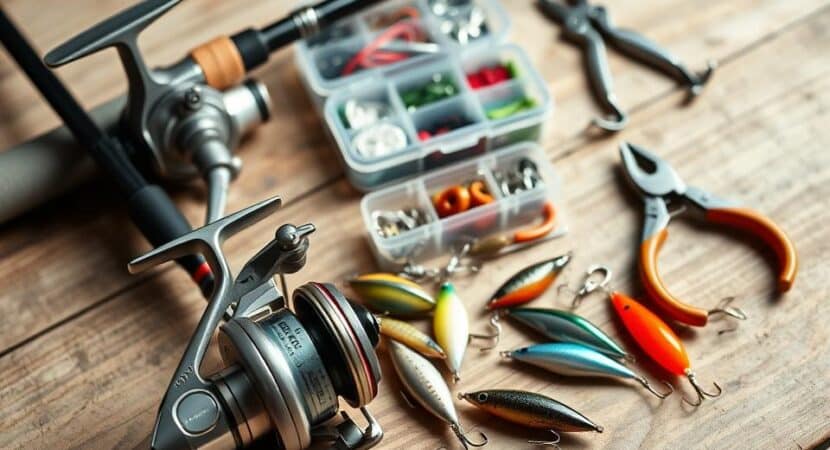

Reply